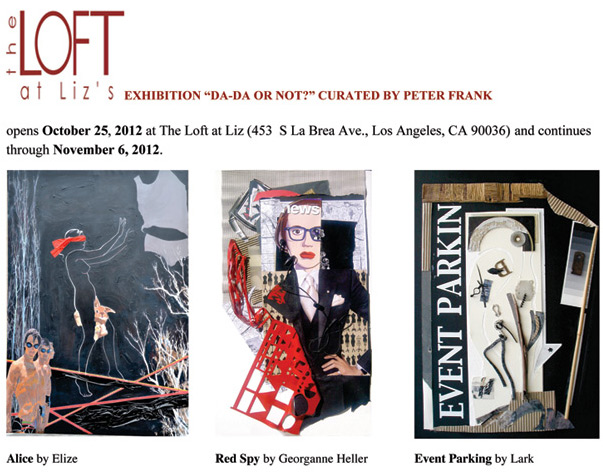 |
||||||||
|---|---|---|---|---|---|---|---|---|
OPENING RECEPTION WITH LIVE MUSIC IS ON SATURDAY OCTOBER 27 @6-10 P.M. Peter Frank responded: Two of the three artists here are of Russian origin, so their positive attitude, too, is a matter of “da da.” But is their art Dada? Not in spirit – the movement’s harsh, brittle avant gardism positioned itself squarely against conventional artistic practice and even social and political norm, and we don’t see such envelope-pushing on the part of these artists. (Indeed, from what art do we see such virulently anti-mainstream sentiment these days?) But in practice, the art of these three women was made possible by Dada – which itself funneled the (literally) cutting-edge thinking of, among others, Pablo Picasso, F. T. Marinetti, Kazimir Malevich and Arnold Schoenberg into a maelstrom of modernist re-formation. What these artists, and their own movements, gave Dada was an anti-establishment fury and a “collage aesthetic,” a sense of life as a mosaic of disconnected events. There is no whole to modern life, proposes this collage aesthetic, only an ever-accruing sum of parts. All three artists here do not simply practice a collage aesthetic: they champion it. Their work, individually and collectively, is about the condition of collage, its appropriateness to today’s world and its cognitive pleasures (more than its dissonances). Even when not technically employing the collage medium, they rely on the juxtaposition of disparate images and materials to realize disjunctive compositions in which formal and narrative meaning is revealed, even found, as much as it is built. To be sure, in producing their work, Elize, Georganne Heller, and Lark depend on a fundamental visual logic, calling on their native abilities and training to guide them to natural coherency. But they experiment freely with formats and elements that can challenge not just their skills, but their imaginations, sending them onto new structural and narrative paths. To be sure, they also make unabashed reference to the real world, as Elize and Lark do in their fantasy landscapes and Heller does in her figures. Heller’s cut-out-doll-like take on fashion, Lark’s knowing embrace of a romantic spiritualism in her landscapes, and Elize’s arch juxtapositions of images in space all play with the real world rather than curse it or mock it. “In a way,” writes Lark of herself and her two comrades-in-collage, the three women “still have their lonely child inside them, wanting to play, making friends with their creations rather than with real people.” If this is Dada, it is a gentled Dada for a new, perhaps more hopeful era. Peter Frank For photos and interviews with artists, please contact our publicist:
|
||||||||
|
Copyright © Larkgallery • All rights reserved • Website by Larkgallery |
||||||||